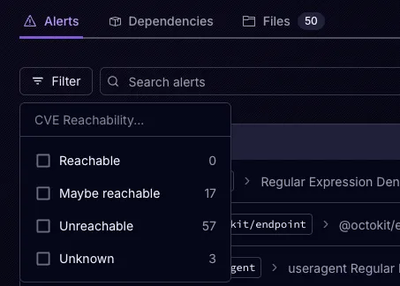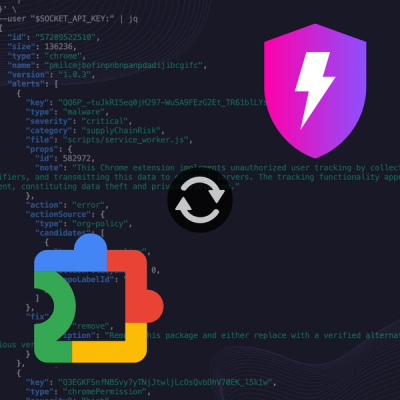
Product
Announcing Precomputed Reachability Analysis in Socket
Socket’s precomputed reachability slashes false positives by flagging up to 80% of vulnerabilities as irrelevant, with no setup and instant results.
A easy-to-use, robust, file-based DB for Node. Acts as an append-only store for objects.

When writing NodeJs projects I often find I need an easy-to-use, understandable, yet robust database that I can throw into my project without needing to install another database server and configure a connection etc.
What I needed was a dead simple library that I could plug into any project and that would:
And so Baby DB was born.
Baby DB stores data in an append only log file. This makes it almost impossible to lose data (except if the underlying hardware fails). It’s also a very flexible way to store data - it’s easy to add fields, change the schema and so on by upgrading the processor.
Each instance requires us to pass in a “processor” that consumes each record and aggregates or stores it for use by the rest of the system. Baby DB itself streams the data records so it has very low memory overhead.
To keep things simple, while you could have all data stored in a single log file, it may be better to store each “table” of data in it’s own file.
const babydb = require('baby-db');
...
const db1 = babydb(file1);
db1.on('error', err => console.error(err));
db1.on('rec', (rec, linenum) => {
switch(rec.type) {
case 'new':
DATA1[rec.userid] = rec.info;
break;
case 'update':
if(!DATA1[rec.userid]) throw `Cannot update non-existent record on line: ${linenum}`;
Object.assign(DATA1[rec.userid], rec.info);
break;
case 'delete':
delete DATA1[rec.userid];
break;
default:
throw `Did not understand record type: "${rec.type}", on line: ${linenum}`.
}
})
db1.on('done', () => {
console.log("ready to rumble....!")
});
...
function annoyed_jack() {
const jack = 2;
db1.add({ type: 'new', userid: jack, info: { name: 'jack', mood: 'annoyed'}})
db1.add({ type: 'update', userid: jack, info: { mood: 'really annoyed'}})
db1.add({ type: 'delete', userid: jack})
}
function sleepy_jill() {
const jill = 3;
db1.add({ type: 'new', userid: jill, info: { name: 'jill', mood: 'sleepy'}})
db1.add({ type: 'update', userid: jill, info: { mood: 'hungry'}})
}
...
db1.onExitSignal(() => process.exit())
Baby DB is designed to support persisting it’s data and cleanly exiting. You can do this by calling db.stop() or (recommended), by installing the onExitSignal() handler which will trap all common exit signals and flush the data to disk.
babydb.onExitSignal(() => {
process.exit() // use process.exit() otherwise the application will not exit
})
There are cases when you only want to manage the records transiently (without persisting). To do this, simply omit the file parameter from Baby DB and it will keep all records in memory. If you want the records to be printed to the console, pass the number 0 as the file and it will redirect records to the standard console.
Baby DB supports the following options (defaults shown):
const db1 = babydb(file, {
loadOnStart: true, // otherwise call load()
saveEvery: 3000, // persist to disk every 3 seconds
maxRecsEvery: 3072, // any additional spike of records beyond 3072 every 3 seconds will raise an 'overflow' event
unmanaged: false, // stopAll() and onExitSignal() will ignore this database if true
rolloverLimit: 0 // causes the file to roll over when the number of records goes over (see below)
})
When using an append-only log, it's common to find that it grows very large very quickly.
Baby DB handles this problem by allowing you to specify a rolloverLimit in your options. Once the number of records in a file goes beyond this number, it is archived in the format:
filename-<timestamp>-<number of records>.ext
NB: The number of records in the file could be above the actual rolloverLimit depending on how many additional records came in during the write period.
When we set a rollover, the old records are no longer processed and so, we need to re-populate the database with a set of new, 'clean', records that captures the lastest state of our database. To do this, listen for the 'rollover' event and use that to add the these clean records. For example:
db1.on('rollover', create_summary_records);
function create_new_clean_records() {
// Remember you may need to make a copy of your
// existing data structure because adding
// new records will cause the existing data
// structures to be updated with the 'rec' handler
db1.add({ type: 'new', info: { ... }, meta: { ... }}))
}
There are times we would like to "clean" the database without waiting for the rollover limit to be reached. In such a case we can call the db.rollover() function directly. This will cause the data to flush to disk and then the rollover to be performed.
db1.rollover(() => console.log("rollover done!");
Rollover is careful to first flush all records and only then trigger the new rollover file. This means that, even if it fails in between, all you need to do is to restore the database from the roll-ed over file.
Baby DB provides an option for ignoring data ‘spikes’ that may come up either accidentally or due to some malicious intent.
To handle overflow records, listen for the ‘overflow’ event:
userdb.on('overflow', rec => {
// alert the navy
save_somewhere_else(rec)
})
By default more than 1024 records every second is considered an ‘overflow’. This is easily changed using the options described in the Options section. In particular, setting the maxRecsEvery parameter to 0 will have BabyDB never mark any records as ‘overflow’.
Enjoy!
FAQs
Easy to Use, Robust, file-based DB for Node
The npm package baby-db receives a total of 1 weekly downloads. As such, baby-db popularity was classified as not popular.
We found that baby-db demonstrated a not healthy version release cadence and project activity because the last version was released a year ago. It has 1 open source maintainer collaborating on the project.
Did you know?

Socket for GitHub automatically highlights issues in each pull request and monitors the health of all your open source dependencies. Discover the contents of your packages and block harmful activity before you install or update your dependencies.

Product
Socket’s precomputed reachability slashes false positives by flagging up to 80% of vulnerabilities as irrelevant, with no setup and instant results.

Product
Socket is launching experimental protection for Chrome extensions, scanning for malware and risky permissions to prevent silent supply chain attacks.

Product
Add secure dependency scanning to Claude Desktop with Socket MCP, a one-click extension that keeps your coding conversations safe from malicious packages.